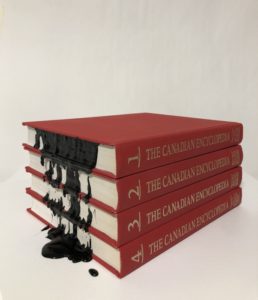Liquid black rubber drips off the pages of White Man’s Africa, a book written in 1899. This record of white supremacy in Africa is no longer readable, and that’s the point. Along with many other altered and redacted works, this piece in Chantal Gibson’s upcoming exhibit at Open Space explores what it actually means to decolonize.
Gibson is multimodal, just like her work. She is an award-winning educator, a highly respected artist, and a genre-bending writer. Her deeply moving book of poetry, How She Read, examines the representations of black women in Canadian culture.
A Grammar of Loss takes its name from the first section of How She Read. Through the use of cloze activities—the blank spaces in words used to teach children how to read and spell—Gibson points out that when learning to read, we begin with loss. The exhibit expands on another exhibit and residency Gibson presented last year, How She Read: Confronting the Romance of Empire.

“When I left that residency, I left with some questions about… what does it actually mean to decolonize?” says Gibson. “I started thinking about how ideology works.”
Gibson explores the lessons we learn as children, both the curriculum and the cultural lessons that are imparted through that process. Whether intended or not, our classrooms include a lesson about our identities and what our place in the world is.
“If you are a young black girl reading texts that don’t contain any representation of you, or the representation of black people is really pejorative or racist, or we see old books that contain very sexist or misogynist imagery, we take that in,” says Gibson. “That’s also what we learn.”
Using the liquid rubber, Gibson communicates in her art the stickiness of these insidious ideologies. Some of the texts she uses can never again be opened—on one hand, that can feel uncomfortable, but that’s the nature of redaction.
“I imagine maybe this is what it’s like when the Black voice gets to speak,” says Gibson. “There’s something about redaction that has this privilege, even redacting of who understands—who gets to read what.”
What Gibson is exploring in A Grammar of Loss is understanding what’s meant not only in the exclusion but also in the letting go of certain books in the process of decolonizing.
“There are some books—there’ll be a few books in the show—that I don’t think need to be read again,” says Gibson. “I think we’re good.”
Gibson’s 2018 installation Souvenir is featured in A Grammar of Loss. This work was commissioned by the Royal Ontario Museum for Here We Are Here: Black Canadian Contemporary Art, the first show of its kind. It’s a collection of 2,000 souvenir spoons painted black. The spoons represent the complicated realities of Black people in Canada. Everyone’s story is unique, but Black people have been homogenized.
“At the same time, when you see 2,000 Black hanging bodies [they] bring up a long kind of shared history of Blackness,” she says. “Working with black paint, black ink, and now this liquid rubber, it is a rhetorical device.”
The pieces in these exhibits are meant to be visually appealing, but this art is designed to be evocative and thought-provoking.
“The only reason I’m making art [is] because I’m trying to find a way to communicate something that means a lot to me,” says Gibson. “Even with my book of poetry, every one of those poems is just a sculpture, but there are some things that we just cannot communicate in words.”
A Grammar of Loss: Studies in Erasure
Friday, February 21 to Saturday, March 28
Free or by donation, Open Space
openspace.ca

